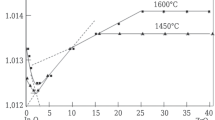Abstract
O2, Cl2, and SO2 chemisorption on the surface of nanocrystalline In2O3 doped with antimony (0.2 and 2.7 at %) has been studied at temperatures from 22 to 200°C. The results indicate that antimony prevents the formation of nonconducting indium chlorides on the surface of nanocrystalline In2O3 during Cl2 chemisorption. The logarithm of the conductivity of Sb-doped In2O3 is a nearly linear function of the surface coverage with chlorine, which makes it a candidate chlorine-sensing material. At the same time, antimony doping reduces the SO2 response of In2O3.
Similar content being viewed by others
References
Starke, Th.K.H., Coles, G.S.V., and Ferkel, H., High Sensitivity NO2 Sensors for Environmental Monitoring Produced Using Laser Ablated Nanocrystalline Metal Oxides, Sens. Actuators, B, 2002, vol. 85, no. 3, pp. 239–245.
Gurlo, A., Ivanovskaya, M., Barsan, N., et al., Grain Size Control in Nanocrystalline In2O3 Semiconductor Gas Sensors, Sens. Actuators, B, 1997, vol. 44, nos. 1–3, pp. 327–333.
Epifani, M., Capone, S., Rella, R., et al., In2O3 Thin Films Obtained through a Chemical Complexation Based Sol-Gel Process and Their Application As Gas Sensor Devices, J. Sol-Gel Sci. Technol., 2003, vol. 26, nos. 1–3, pp. 741–744.
Vol’kenshtein, F.F., Elektronnye protsessy na poverkhnosti poluprovodnikov pri khemosorbtsii (Chemisorption-Induced Electronic Processes on Semiconductor Surfaces), Moscow: Nauka, 1979.
Tamaki, J., Nauro, Ch., Yamamoto, Y., and Matsuoka, M., Sensing Properties to Dilute Chlorine Gas of Indium Oxide Based Thin Film Sensors Prepared by Electron Beam Evaporation, Sens. Actuators, B, 2002, vol. 83, nos. 1–3, pp. 190–194.
Tamaki, J., Niimi, J., Ogura, Sh., and Konishi, S., Effect of Micro-gap Electrode on Sensing Properties to Dilute Chlorine Gas of Indium Oxide Thin Film Microsensors, Sens. Actuators, B, 2006, vol. 117, no. 2, pp. 353–358.
Gurlo, A., Barsan, N., Ivanovskaya, M., et al., In2O3 and MoO3-In2O3 Thin Film Semiconductor Sensors: Interaction with NO2 and O3, Sens. Actuators, B, 1998, vol. 47, nos. 1–3, pp. 92–99.
Korotcenkov, G., Boris, I., Brinzari, V., et al., Gas-Sensing Characteristics of One-Electrode Gas Sensors Based on Doped In2O3 Ceramics, Sens. Actuators, B, 2003, vol. 103, nos. 1–2, pp. 13–22.
Kim, S.-R., Hong, H.-K., Kwon, Ch.H., et al., Ozone Sensing Properties of In2O3-Based Semiconductor Thick Films, Sens. Actuators, B, 2000, vol. 66, nos. 1–3, pp. 59–62.
Vinokurova, M.V., Derlyukova, L.E., and Vinokurov, A.A., SO2 Chemisorption on the Surface of Zn-Doped In2O3, Izv. Akad. Nauk, Ser. Khim., 2005, vol. 54, no. 10, pp. 2228–2232.
Vinokurov, A.A., Initial Stages in the Reactions of Zinc and Iron(III) Oxides with Chlorine and Sulfur Dioxide, Cand. Sci. (Chem.) Dissertation, Chernogolovka: Inst. of New Chemical Problems, Russ. Acad. Sci., 1988.
Handbuch der präparativen anorganischen Chemie in drei Bänden, von Brauer, G., Ed., Stuttgart: Ferdinand Enke, 1978, 3rd ed.
Tablitsy fizicheskikh velichin. Spravochnik (Tables of Physical Quantities: A Handbook), Kikoin, I.K., Ed., Moscow: Atomizdat, 1976.
Roginskii, S.Z., Geterogennyi kataliz (Heterogeneous Catalysis), Moscow: Nauka, 1979.
Vinokurova, M.V. and Derlyukova, L.E., Reactions of Cl2 and SO2 with Fine-Particle In2O3, Elektrokhimiya, 2005, vol. 41, no. 5, pp. 529–536.
Vinokurova, M.V., Derlyukova, L.E., Vinokurov, A.A., et al., Initial Stages in the Reactions of Gallium and Indium Oxides with Chlorine, Zh. Neorg. Khim., 1991, vol. 36, no. 10, pp. 2480–2486.
Vinokurov, A.A., Derlyukova, L.E., and Evdokimov, V.I., Chlorine and Sulfur Dioxide Chemisorption on Zinc Oxide, Izv. Akad. Nauk SSSR, Ser. Khim., 1986, vol. 35, no. 9, pp. 1927–1931.
Vinokurova, M.V., Vinokurov, A.A., and Derlyukova, L.E., Effect of Antimony Doping on the Sorptive Properties of SnO2, Izv. Akad. Nauk, Ser. Khim., 2003, vol. 52, no. 7, pp. 1411–1414.
Author information
Authors and Affiliations
Corresponding author
Additional information
Original Russian Text © M.V. Vinokurova, L.E. Derlyukova, A.A. Vinokurov, 2007, published in Neorganicheskie Materialy, 2007, Vol. 43, No. 10, pp. 1211–1218.
Rights and permissions
About this article
Cite this article
Vinokurova, M.V., Derlyukova, L.E. & Vinokurov, A.A. Sorptive properties of antimony-doped In2O3 . Inorg Mater 43, 1085–1092 (2007). https://doi.org/10.1134/S0020168507100111
Received:
Issue Date:
DOI: https://doi.org/10.1134/S0020168507100111




